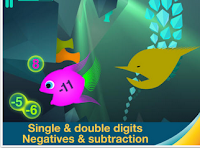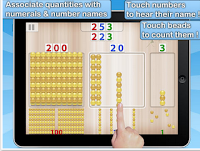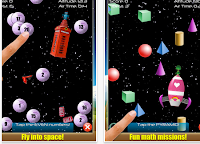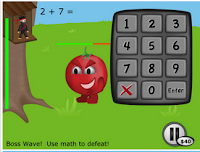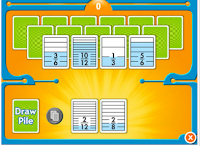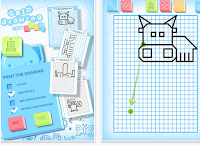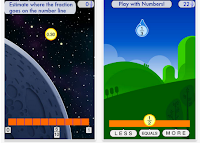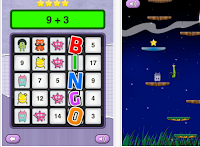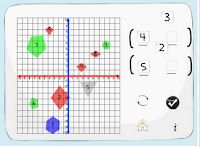24 Good iPad Math Apps for Elementary Students
http://www.educatorstechnology.com/2013/12/24-good-ipad-math-apps-for-elementary.html
1- Motion Math
Feed your fish and play with numbers! Practice mental addition and subtraction with Motion Math: Hungry Fish, a delightful learning game that’s fun for children and grownups.
2- Geoboard
The Geoboard is a tool for exploring a variety of mathematical topics introduced in the elementary and middle grades. Learners stretch bands around pegs to form line segments and polygons and make discoveries about perimeter, area, angles, congruence, fractions, and more.
3- Math Vs Zombies
The world is overrun with zombies. You are a part of a squad of highly trained scientists who can save us. Using your math skills and special powers you can treat infected zombies to contain the threat.
4- Mystery Math Town
It’s part math drills, part seek and find game and totally engaging. Kids ages five and up should find this both fun and challenging. Parents should rejoice that finally there is a way to get kids to want to do more math. – Smart Apps for Kids
5- Montessori Numbers
Montessori Numbers offers a sequence of guided activities that gradually help children reinforce their skills. Each activity offers several levels of increasing complexity
6- Free Kids Counting Game
FREE and fun picture math games for kids designed by the iKidsPad team. This free iPad math app dynamically generates thousand of beginning counting games with different themes and number levels. Great interactive and challenging games helps young children build up basic counting skills and number recognition.
7- Math Puppy
Math Puppy will take you on a journey of educational fun like never before!
From toddlers to grade school, for Children of all ages – Math Puppy is the perfect way to build up your math skills. Your child will be able to enjoy a constructive, supportive, interactive fun filled environment while mastering the arts of basic math.
8- Mathmateer
While your rocket is floating weightlessly in space, the real fun begins! Play one of the many fun math missions. Each mission has touchable objects floating in space, including stars, coins, 3D shapes and more! Earn a bronze, silver or gold medal and also try to beat your high score. Missions range in difficulty from even/odd numbers all the way to square roots, so kids and their parents will enjoy hours of fun while learning math.
9- Math Ninja
Use your math skills to defend your treehouse against a hungry tomato and his robotic army in this fun action packed game! Choose between ninja stars, smoke bombs, or ninja magic – and choose your upgrades wisely!
10- Everyday Mathematics
The Equivalent Fractions game by McGraw Hill offers a quick and easy way to practice and reinforce fraction concepts and relationships. This game runs on the iPad, iPhone, and iPod Touch.
11- Elementary School Math
Based on the classroom hit Middle School Math HD, Elementary School Math HD is a stunningly beautiful and powerfully engaging application built for today’s technology-driven elementary school classroom. Emphasizing game-playing and skill development, the eight modules in Elementary School Math HD have been carefully designed by classroom teachers to provide the perfect balance between fun and the practice of fundamental skills
12- Math Tappers
MathTappers: Multiples is a simple game designed first to help learners to make sense of multiplication and division with whole numbers, and then to support them in developing fluency while maintaining
accuracy.
13- Ordered Fractions
Two Player Bluetooth Math Game! You can use two devices and play competitively or cooperatively with your classmates or parents. Ordered Fractions provides a comprehensive tool that offers an innovative method of learning about comparing and ordering fractions.
14- SlateMath
SlateMath is an iPad app that develops mathematical intuition and skills through playful interaction. The app’s 38 activities prepare children for kindergarten and first grade math. SlateMath forms the foundation of numbers, digit writing, counting, addition, order relation, patterns, parity and problem solving.
15- NumberStax
Number Stax is a puzzle game to test your number skills! Drop numbers and operators in the correct places to match the number or expression shown at the top of the screen to score. You can’t remove tiles but you can swap them around. You can freeze the game at any time, but remember to watch the clock! Eliminate tiles, score points, and earn bonuses and achievements for as long as possible until your grid is full! Remember, the longer you play the faster it gets. Share with your family and friends to see who can get the highest score.
16- Grid Drawing
With a sheet of paper, a grid and a template, your children will be able to draw 32 drawings on iPad, 16 on the iPhone in the Lite version, more than 120 (60 on iPhone) in the full version.
17- Motion Math
Developed at the Stanford School of Education, Motion Math HD follows a star that has fallen from space, and must bound back up, up, up to its home in the stars. Moving fractions to their correct place on the number line is the only way to return. By playing Motion Math, learners improve their ability to perceive and estimate fractions in multiple forms.
18- 5th Grade Math
Splash Math is a fun and innovative way to practice math. With 9 chapters covering an endless supply of problems, it is by far the most comprehensive math workbook in the app store.
19- Sushi Monster
Meet Sushi Monster! Scholastic’s new game to practice, reinforce, and extend math fact fluency is completely engaging and appropriately challenging.
20- Math Monsters
Math Monsters Bingo is a new, fun way to master math on your iPhone, iPad and iPod touch. The game lets you practice math anytime and anywhere using a fun Bingo styled game play.
21- Grid Lines
Grid Lines is a Battleship-style math game used to teach students the coordinate plane by plotting points in all four quadrants.
22- Marble Math
From: Miltenoff, Plamen
Sent: Wednesday, November 20, 2013 4:09 PM
To: ‘technology@lists.mnscu.edu’; ‘edgamesandsims@lists.mnscu.edu’
Cc: Oyedele, Adesegun
Subject: virtual worlds and simulations
Good afternoon
Apologies for any cross posting…
Following a request from fellow faculty at SCSU, I am interested in learning more about any possibilities for using virtual worlds and simulations opportunities [in the MnSCU system] for teaching and learning purposes.
The last I remember was a rather messy divorce between academia and Second Life (the latter accusing an educational institution of harboring SL hackers). Around that time, MnSCU dropped their SL support.
Does anybody have an idea where faculty can get low-cost if not free access to virtual worlds? Any alternatives for other simulation exercises?
Any info/feedback will be deeply appreciated.
Plamen
After Frustrations in Second Life, Colleges Look to New Virtual Worlds. February 14, 2010
—–Original Message—–
From: Weber, James E.
Sent: Wednesday, November 20, 2013 5:41 PM
To: Miltenoff, Plamen Subject: RE: virtual worlds and simulations
Hi Plamen:
I don’t use virtual worlds, but I do use a couple of simulations…
I use http://www.glo-bus.com/ extensively in my strategy class. It is a primary integrating mechanism for this capstone class.
I also use http://erpsim.hec.ca/en because it uses and illustrates SAP and process management.
http://www.goventure.net/ is one I have been looking into. Seems more flexible…
Best,
Jim
From: brock.dubbels@gmail.com [mailto:brock.dubbels@gmail.com] On Behalf Of Brock Dubbels
Sent: Wednesday, November 20, 2013 4:29 PM
To: Oyedele, Adesegun
Cc: Miltenoff, Plamen; Gaming and Simulations
Subject: Re: virtual worlds and simulations
That is fairly general
what constitutes programming skill is not just coding, but learning icon-driven actions and logic in a menu
for example, Sketch Up is free. You still have to learn how to use the interface.
there is drag and drop game software, but this is not necessarily a share simulation
From: Kalyvaki, Maria [mailto:Maria.Kalyvaki2@smsu.edu]
Sent: Wednesday, November 20, 2013 4:26 PM
To: Miltenoff, Plamen
Subject: RE: virtual worlds and simulations
Hi,
I received this email today and I am happy that someone is interested on Second Life. The second life platform and some other virtual worlds are free to use. Depends what are your expectations there that may increase the cost of using the virtual world. I am using some of those virtual worlds and my previous school Texas Tech University was using SL for a course.
Let me know how could I help you with the virtual worlds.
With appreciation,
Maria
From: Jane McKinley [mailto:Jane.McKinley@riverland.edu]
Sent: Thursday, November 21, 2013 11:09 AM
To: Miltenoff, Plamen
Cc: Jone Tiffany; Pamm Tranby; Dan Harber
Subject: Virtual worlds
Hi Plamen,
To introduce myself I am the coordinator/ specialist for our real life allied health simulation center at Riverland Community College. Dan Harber passed your message on to me. I have been actively working in SL since 2008. My goal in SL was to do simulation for nursing education. I remember when MnSCU had the island. I tried contacting the lead person at St. Paul College about building a hospital on the island for nursing that would be open to all MN programs, but never could get a response back.
Yes, SL did take the education fees away for a while but they are now back. Second Life is free in of itself, it is finding islands with educational simulations that takes time to explore, but many are free and open to the public. I do have a list of islands that may be of interest to you. They are all health related, but there are science islands such as Genome Island. Matter of fact there is a talk that will be out there tonight about how to do research and conduct fair experiments at 7:00 our time.
I have been lucky to find someone with the same goals as I have. Her name is Jone Tiffany. She is a professor at Bethel University in the nursing program. In the last 4 years we have built an island for nursing education. This consists of a hospital, clinic, office building, classrooms and a library. We also built a simulation center. (Although I accidently removed the floor and some walls in it. Our builder is getting it back together.) There is such a shortage of real mental health and public health sites that a second island is being purchased to meet this request. On that island we are going to build an inner city, urban and rural communities. This will be geared towards meeting those requests. Our law enforcement program at Riverland has voiced an interest in SL with being able to set up virtual crime scenes which could be staged anywhere on the two islands. With the catastrophic natural events and terrorist activities that have occurred recently we will replicate these same communities on the other side of the island only it will be the aftermath of a hurricane and tornado, or flooding. On the other side we could stage the aftermath of a bombing such as what happened in Boston. Victims could transported to the hospital ED. Law enforcement could do an investigation.
We have also been working with the University of Wisconsin, Osh Kosh. They have a plane crash simulation and what we call a grunge house that students go into to see what the living conditions are like for those who live in poverty and what could be done about it.
Since I am not faculty I cannot take our students out to SL, but Jone has had well over 100 of her students in there doing various assignments. She is taking more out this semester. They have done such things as family health assessments and diabetes assessment and have to create a plan of care. She has done lectures out there. So the students come out with their avatars and sit in a classroom. This is a way distant learning can be done but yet be engaged with the students. The beauty of SL is that you can be creative. Since the island is called Nightingale Isle, some of the builds are designed with that theme in mind. Such as the classrooms, they are tiered up a mountain and look like the remains of a bombed out church from the Crimean War, it is one of our favorite spots. We also have an area open on the island for support groups to meet. About 5 years ago Riverland did do a congestive heart failure simulation with another hospital in SL. That faculty person unfortunately has left so we have not been able to continue it, but the students loved it. We did the same scenario with Jones students in the sim center we have and again the students loved it.
The island is private but anyone is welcome to use it. We do this so that we know and can control who is on the island. All that is needed is to let Jone or I know who you are, where are you from (institution), and what is your avatar name. We will friend you in SL and invite you to join the group, then you have access to the island. Both Jone and I are always eager to share what all goes on out there (as you can tell by this e-mail). There is so much potential of what can be done. We have been lucky to be able to hire the builder who builds for the Mayo Clinic. Their islands are next to ours. She replicated the Gonda Building including the million dollar plus chandeliers.
I can send you the list of the health care related islands, there are about 40 of them. I also copied Jone, she can give you more information on what goes into owning an island. We have had our ups and downs with this endeavor but believe in it so much that we have persevered and have a beautiful island to show for it.
Let me if you want to talk more.
Jane (aka Tessa Finesmith-avatar name)
Jane McKinley, RN
College Lab Specialist -Riverland Center for Simulation Learning
Riverland Community College
Austin, MN 55912
jane.mckinley@riverland.edu
507-433-0551 (office)
From: Jeremy Nienow [mailto:JNienow@inverhills.mnscu.edu]
Sent: Thursday, November 21, 2013 10:11 AM
To: Miltenoff, Plamen
Cc: Sue Dion
Subject: Teaching in virtual worlds
Hello,
A friend here at IHCC sent me your request for information on teaching in low-cost virtual environments.
I like to think of myself on the cusp of gamification and I have a strong background in gaming in general (being a white male in my 30s).
Anyway – almost every MMORPG (Massive Multi-online role playing game) today is set up on a Free to Play platform for its inhabitance.
There are maybe a dozen of these out there right now from Dungeon and Dragons online, to Tera, to Neverwinter Nights…etc.
Its free to download, no subscription fee (like there used to be) and its free to play – how they get the money is they make game items and cool aspects of the game cost money…people pay for the privilege of leveling faster.
So – you could easily have all your students download the game (provided they all have a suitable system and internet access), make an avatar, start in the same place – and teach right from there.
I have thought of doing this for an all online class before, but wanted to wait till I was tenured.
Best,
Jeremy L. Nienow, PhD., RPA
Anthropology Faculty
Inver Hills Community College
P.S. Landon Pirius (sp?) who was once at IHCC and now I believe is at North Hennepin maybe… wrote his PhD on teaching in online environments and used World of Warcraft.
From: Gary Abernethy [mailto:Gary.Abernethy@minneapolis.edu]
Sent: Thursday, November 21, 2013 8:46 AM
To: Miltenoff, Plamen
Subject: Re: [technology] virtual worlds and simulations
Plamen,
The below are current options I am aware of for VW and SIM . You may also want to take a look at Kuda, in Google code, I worked at SRI when we developed this tool. I am interested in collaboration in this area.
Hope the info helps
https://www.activeworlds.com/index.html
http://www.opencobalt.org/
http://opensimulator.org/wiki/Main_Page
http://metaverse.sourceforge.net/
http://stable.kuda.googlecode.com
Gary Abernethy
Director of eLearning
Academic Affairs
Minneapolis Community and Technical College | 1501 Hennepin Avenue S. | Minneapolis, MN 55403
Phone 612-200-5579
Gary.Abernethy@minneapolis.edu | http://www.minneapolis.edu
From: John OBrien [mailto:John.OBrien@so.mnscu.edu]
Sent: Wednesday, November 20, 2013 11:37 PM
To: Miltenoff, Plamen
Subject: RE: virtual worlds and simulations
I doubt this is so helpful, but maybe: http://wiki.secondlife.com/wiki/SLED
http://mashable.com/2013/11/16/finland-tech-education-schools/?utm_cid=mash-prod-email-topstories&utm_emailalert=daily&utm_source=newsletter&utm_medium=email&utm_campaign=daily
Finland Eyes Programming Classes for Elementary School Students
————————–
Beyond Mindcraft: Games That Inspire Building and Exploration
http://blogs.kqed.org/mindshift/2013/11/beyond-minecraft-games-that-inspire-building-and-exploration/
 Garry’s Mod (GMod) is a sandbox game like Minecraft but instead of building and exploring, students use a fun physics engine that simulates things like gravity and mass. They also use a virtual toy box of assets from Valve Software’s popular games. The tool is a step up in complexity from the elegant simplicity of Minecraft, but with Garry’s Mod,students are exposed to physics concepts while having madcap fun.
Garry’s Mod (GMod) is a sandbox game like Minecraft but instead of building and exploring, students use a fun physics engine that simulates things like gravity and mass. They also use a virtual toy box of assets from Valve Software’s popular games. The tool is a step up in complexity from the elegant simplicity of Minecraft, but with Garry’s Mod,students are exposed to physics concepts while having madcap fun.
 Kerbal Space Program has a robust physics engine too, but it’s more focused than Garry’s Mod. Players purchase rocket parts, put them together, and then see if they can get a ship into orbit, to one of two moons, or even to another planet. These aren’t easy tasks, so play is focused on trial and error testing, and, like Minecraft, seeking help from the community is part of a successful strategy.
Kerbal Space Program has a robust physics engine too, but it’s more focused than Garry’s Mod. Players purchase rocket parts, put them together, and then see if they can get a ship into orbit, to one of two moons, or even to another planet. These aren’t easy tasks, so play is focused on trial and error testing, and, like Minecraft, seeking help from the community is part of a successful strategy.
 Sound Shapes is a visually stunning platform puzzle game set to a rich musical soundscape. Even better: students can create and share their own levels – like interactive sheet music — using sounds and objects unlocked by playing the platform game. It’s an accessible entry point into musical composition as well as game design, and provides an experience that builds on the creativity of Minecraft while offering something wholly unique for music lovers.
Sound Shapes is a visually stunning platform puzzle game set to a rich musical soundscape. Even better: students can create and share their own levels – like interactive sheet music — using sounds and objects unlocked by playing the platform game. It’s an accessible entry point into musical composition as well as game design, and provides an experience that builds on the creativity of Minecraft while offering something wholly unique for music lovers.
 For creative kids who want to get their hands dirty, check out DIY, a site where students can find things to build, instructions for how to build them, and ways to share their creations with others. All projects are aligned to 50 skills that run the gamut from outdoors to indoors, and feature various challenges to complete and cool badges to earn and display.
For creative kids who want to get their hands dirty, check out DIY, a site where students can find things to build, instructions for how to build them, and ways to share their creations with others. All projects are aligned to 50 skills that run the gamut from outdoors to indoors, and feature various challenges to complete and cool badges to earn and display.
 Computer programming is a great next step for students who love to mod Minecraft or toy around with the redstone resource (which simulates basic logic and circuitry). One solid entry-level tool is Stencyl, a game creation program focused on codeless, cross-platform game making. By snapping blocks of code together, students can create games that can be published and played on a variety of platforms including mobile phones.
Computer programming is a great next step for students who love to mod Minecraft or toy around with the redstone resource (which simulates basic logic and circuitry). One solid entry-level tool is Stencyl, a game creation program focused on codeless, cross-platform game making. By snapping blocks of code together, students can create games that can be published and played on a variety of platforms including mobile phones.
 Codecademy is a web-based, self-paced site that teaches actual industry-standard languages like PHP, Javascript, Python, Ruby, HTML, and CSS. While students don’t create publishable games like they would in Stencyl, their learning is purpose-driven and contextualized, e.g. JavaScript for web development or Ruby for app development. And students do get to see their code’s output directly onscreen.
Codecademy is a web-based, self-paced site that teaches actual industry-standard languages like PHP, Javascript, Python, Ruby, HTML, and CSS. While students don’t create publishable games like they would in Stencyl, their learning is purpose-driven and contextualized, e.g. JavaScript for web development or Ruby for app development. And students do get to see their code’s output directly onscreen.
Minecraft has introduced a lot of youth to games as well as the critical thinking, problem solving, and creation skills necessary for self-motivated learning. The games and sites on this list have the potential to extend that learning, providing fresh outlets for self-expression in the digital world and beyond.






















